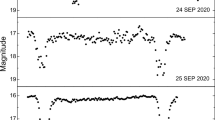Photometric data in the JHKLM near infrared bands obtained in 1999-2000 are presented for the long-period eclipsing system ε Aur. The time of secondary eclipse (when the F21 supergiant eclipses a dust disk surrounding the more massive component of the system) is calculated using the latest orbital elements of the system. A brightness minimum with an amplitude of ~0m.05 is observed in all bands at the phase of the expected secondary eclipse (φ = 0.606). The nearest subsequent time of a secondary eclipse, which will occur in December 2026-February 2027, is calculated. It is shown that during the secondary minimum the B5V star currently proposed as the secondary component cannot be eclipsed. It is proposed that the eclipsed component should be a hot star surrounded by a gas-dust cloud and with luminosity and radius exceeding the typical values for Main sequence stars.
Similar content being viewed by others
References
S. M. Carroll, E. F. Guinan, G. P. McCook, and R. A. Donahue, Astrophys. J. 367, 278 (1991).
B. Kloppenborg, R. Stencel, J. D. Monnier, et al., Nature, 464, 870 (2010).
P. van de Kamp, Astron. J. 83, 975 (1978).
M. Hack and P. L. Selvelli, Astron. Astrophys. 75, 316 (1979).
D. W. Hoard, S. B. Howell, and R. E. Stencel, Astrophys. J. 714, 549 (2010).
R. E. Stencel, M. Creech-Eakman, A. Hart, et al., Astrophys. J. 689, 137 (2008).
R. P. Stefanik, G. Torres, J. Lovegrove, et al., Astron. J. 139, 1254 (2010).
P. Chadima, P. Harmanec, S. Yang, et al., IBVS 5937 (2010).
O. G. Taranova and V. I. Shenavrin, Pis’ma v Astron. zh. 27, 393 (2001).
V. I. Moroz, O. G. Taranova, V. I. Shenavrin, and B. F. Yudin, Astron. tsirkulyar, No. 1056 (1979).
A. E. Nadzhip, V. I. Shenavrin, and V. G. Tikhonov, Tr. Gos. astron. in-ta im. P. K. Shternberga 58, 119 (1986).
V. Straizys, Multicolor Photometry of Stars [in Russian], Mokslas, Vilnius (1977).
R. O. Gray and C. J. Corbally, Stellar spectral classification, Princeton University Press (2009).
Author information
Authors and Affiliations
Corresponding author
Additional information
Translated from Astrofizika, Vol. 57, No. 3, pp. 401-406 (August 2014).
Rights and permissions
About this article
Cite this article
Maslov, I.A., Nadjip, A.E., Taranova, O.G. et al. JHKLM-Observations of the Unique Eclipsing System ε Aur During a Secondary Minimum. Astrophysics 57, 370–374 (2014). https://doi.org/10.1007/s10511-014-9342-9
Received:
Accepted:
Published:
Issue Date:
DOI: https://doi.org/10.1007/s10511-014-9342-9




